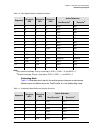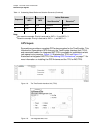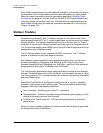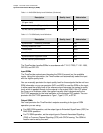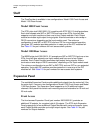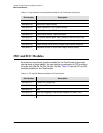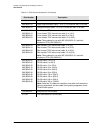
097-58001-02 Revision G – April 2008 TimeProvider User’s Guide 43
Chapter 1 Overview of the TimeProvider
SmartClock
These output formats automatically generate SSMs. The quality level of the
TimeProvider’s output depends on the quality level of the input signal or the quality
level of the local oscillator. During normal operation, when a qualified input is used
as the active timing reference, the TimeProvider copies the input’s quality level to all
DS1 ESF outputs and E1 CAS4 or CCS4 outputs. T1 SSM messages are mapped
to the corresponding equivalent E1 SSM message and vice versa.
If the IOC is operating in Holdover mode for any reason, the SSM quality is the
internal level of the oscillator installed in the IOC.
SmartClock
The TimeProvider uses Symmetricom’s SmartClock technology, which predicts
frequency changes due to aging of the local oscillator in the IOC; this offsets this
deterministic behavior by steering the output with a corrected deviation.
The TimeProvider begins the learning process as soon as you apply a valid external
reference source. The SmartClock technology is enabled after 24 hours of
continuous lock; the TimeProvider then issues an event message similar to this:
IOC1,EQPT,NA,SCAVAIL,NSA,04-12-14,12:13:14:\”SMARTCLOCK ALGORITHM, ENABLED\”
If you reset the IOC or if the oscillator becomes less stable (for example, due to
extreme temperature swings), the TimeProvider disables SmartClock and issues an
event message similar to this:
IOC1,EQPT,NA,SCAVAIL,NSA,04-12-17,15:16:17:\”SMARTCLOCK ALGORITHM, DISABLED\”
The TimeProvider automatically restarts SmartClock, which then begins to
determine a new aging rate for the oscillator.
BesTime
The TimeProvider uses Symmetricom’s BesTime algorithm when it is in the PRR
mode to provide enhanced GR-2830-CORE performance during bridging or
holdover situations. BesTime minimizes the effect of transients on the reference
signal on the outputs of the TimeProvider by comparing them against the system
reference to produce the most stable outputs from the TimeProvider.
The BesTime algorithm is based on Symmetricom’s patented use of multiple-input
phase-locked loops (MPLLs) to generate a correction signal for the local oscillator
(LO) in the IOC. With GPS as the primary input signal in PRR mode, the signals on
the PRS, INP1 and INP2 inputs may be enabled and used in the BesTime
ensembling algorithm to generate output signals derived from the optimum
weighting of each input.





